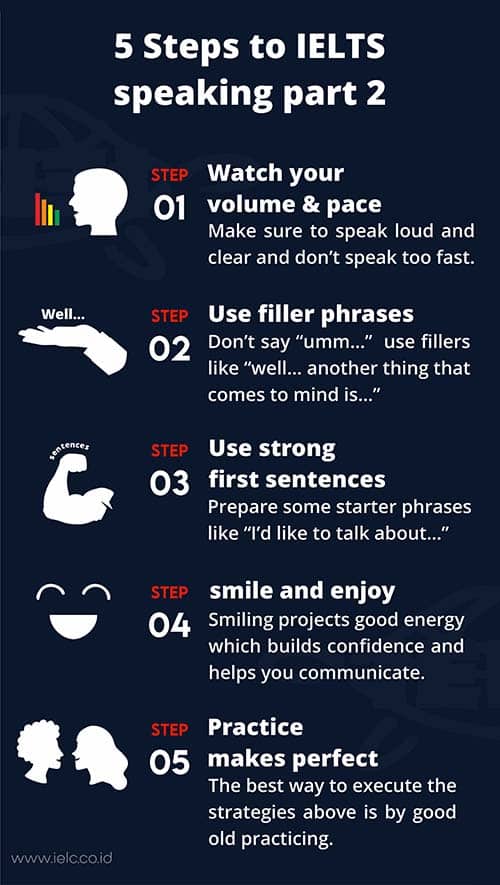
5 strategies you need for IELTS Speaking Part 2
Do you want to know the tips and tricks that you need to nail IELTS Speaking Part 2?
Would you like to know the strategies that successful IELTS participants use?
Or maybe you are looking for an IELTS course? You can contact us directly! You will be guided by experienced teachers who will help you get the best.
If so, you’re going to want to read this article…and make sure to read until the end…you won’t be disappointed.
Let’s start…
In our last IELTS article, we conquered our fear of IELTS Speaking Part 1 in 5 things you need to know about IELTS Speaking Part 1.
We also conquered our fear of big hairy spiders, dangerous snakes and terrifying tokek geckos….remember….toka-toka-toka-toka-tokaaaaaaaak!!
Now, we are going to tackle speaking part 2! So grab a cuppa coffee while we walk you through the strategies to nail speaking part 2!
What happens in IELTS speaking part 2?
You will be asked to give a talk for 1-2 minutes on a particular topic, chosen by the examiner. You will be given a card with the topic plus some bullet points to help you answer the question.
You don’t have to cover all the bullet points but they do provide a helpful starting point for your talk.
Your topic card might look something like this:
Speaking Test Part 2: Candidate Task Card
- Describe a school that you went to when you were a child
You should say:
- Where the school was
- When you went there
- What the school and the teachers were like
- Explain whether you enjoyed your time there
You will have to talk about the topic for 1-2 minutes
You have one minute to think about what you are going to say
You can make some notes to help you if you wish
1. “You will have to talk about the topic for 1 – 2 minutes”
Generally it is better if you talk for at least 1 minute 30 seconds & preferably 2 minutes. Actually, 2 minutes can be both short and long depending on your level.
If you don’t have much to say, then 2 minutes is extremely long…you will end up repeating the same point again and again.
If you have a lot to say, 2 minutes is very short and you will need to organise your thoughts very well to fit in all your talking points.
Hint: unlike part 1, the examiner will not ask you questions so you will have to talk by yourself the whole time.
2. “You have one minute to think about what you are going to say. You can make some notes to help if you wish”.
When you receive your topic card, you will also receive a piece of paper and a pencil to make notes.
You have exactly 1 minute to brainstorm ideas and prepare your talking points.
Hint: the strategies you use during your 1 minute preparation time is crucial to your success in Speaking Part 2. Making notes is definitely recommended.
This minute will feel like the fastest minute of your life. So use your time wisely.
Write as many ideas or keywords about your topic until your 1 minute is up. As we mentioned, 2 minutes can be quite long, so it’s good to have a large selection of ideas ready at your disposal.
However, do not write full sentences. You won’t have enough time. Write short points or keywords instead. You can use what, why, who, where, how as a guide to develop your topic ideas.
You might have difficulties coming up with ideas but DON’T panic. Don’t spend too much time thinking, just start writing any words that come to mind. If no personal experience comes to mind, lie! We know…we know…lying is bad but don’t forget, this is a speaking test not a truth test ☺ It’s okay, we won’t tell anyone!
You can keep and look at your topic card and note throughout the talk.
Now that you have some idea about what IELTS speaking part 2 is like, it’s time to get stuck into the tips and tricks and strategies that you will need to get a high speaking score!

1. Watch your volume and your pace
One of the biggest mistakes test takers make is not speaking loud enough. This is generally because they lack confidence. The problem with this is that it shows you lack confidence, which gives a poor impression to the examiner. So make sure to speak loud and clear.
Another big mistake that test takers make is speaking too fast or too slow. Don’t forget, this is a speaking test not a rap battle. Don’t sound like Rich Brian, you should sound natural.
Speaking too fast makes it very hard for the examiner to understand you. Also, when you race through your topics you risk ending too early because you have run out of things to say.
Hint: If the examiner asks you if you have anything more to add, it probably means you didn’t speak long enough. That’s ok, just use this opportunity to speak more about the topic.
2. Don’t say “um” – use filler phrases instead
This happens to all of us. Sometimes we search for the right word but we just can’t seem to find it. Other times, we can’t help but forget what we were going to say. Don’t worry, it’s not the end of the world. In fact, you can use it to your advantage.
When your mind is blank, DON’T say “um…” or “uh…” instead, make the most of this opportunity to show off the fact that you know a wide range of cohesive devices.
You can use filler phrases such as “well… let me think, it was a long time ago but…” or “what else can I say about that…” or “well… another thing that comes to mind is…”
These phrases sound natural and definitely improve your fluency. After all, native English speakers often use filler phrases.
3. Prepare your first sentence
How you start your talk can greatly impact the rest of the talk! So, it’s important to have a smooth start.
It‘s a good idea to practice a list of starter sentences. These do not have to be long; the goal is to get the ball rolling for the following supporting sentences.
For example, if you get the topic ‘describe your favorite teacher’, your first sentence could be something like “I am lucky to have had several great teachers in the past, but my favorite teacher of all time is definitely Ms.…”
Here are some sample starting sentences you can use to adapt to different topics:
- I’d like to talk about…
- Let me tell you about…
- My favorite thing about … is…
- One thing that left a big impression on me is….
- This is a very interesting topic and I’d like to start by mentioning…
4. Smile and enjoy
Don’t forget to show off your pearly white smile!
Why, you might ask?
Smiling will project positive energy and confidence, which not only gives a good impression but also helps you communicate better!
Hint: Did you know that smiling releases endorphins? These are the happy chemicals that help calm your nerves! And what’s more, they are still released even if you are faking your smile!
What happens when you feel more at ease? That’s right, you sound more natural and your pronunciation will sound better!
So, just enjoy the process! It will help you get your rhythm – yeah baby! Conquering your nerves is half the battle. So if you have that under control, you’re going to do fine!
5. Practice makes perfect
Finally, the best way to execute the strategies we have given above is by good old practising.
Google some common IELTS speaking part 2 topics and set your timer for 3 minutes…
Use the first minute for brainstorming ideas and preparing talk points and the remaining 2 minutes for talking. Record yourself and play back the recording. Pay attention to your volume, speed and pauses. Where can you improve?
If you notice that there are too many pauses or you are saying “ummm…” or “uhhh…” or “tokaaaaaaaak!!” too many times, then you should practice using filler phrases.
It is also a good idea to get a practice buddy (or even better, a tutor) to help you prepare for your IELTS speaking test.
Hint: At IELC, we can help you! ;) we have an IELTS VIP Speaking Squad, where you have the chance to practice your skills with other test takers
The End of Part 2
Your examiner will interrupt you after you reach your 2 minute mark. They may ask one or two questions that require a short answer. Then, you will move to part 3.
Your examiner might write some numbers on a piece of paper during your speaking test but DON’T panic. Those numbers are not your score, they are just time references.
Phew…Part 2 is over! Next, it’s time to conquer Part 3.
Summary
We have given you the tips and tricks and strategies that you can use to nail Part 2 of your IELTS speaking score.
If you found this article useful, please share it with other people who will also benefit from reading it (this really helps us).
Of course, it’s normal if you still feel unsure and confused about IELTS. So, if you would like guidance in preparing for your IELTS exam, then please contact us to see how we can help you
Next Steps:
Do you want to achieve your IELTS target?
Preparing for IELTS can be confusing! So, if you’re tired of wasting time on strategies that don’t work…
and…
If you don’t want to waste money on courses that don’t help…
Then check out…
The best IELTS preparation course in Indonesia
At IELC, we teach IELTS the right way.
and…
We teach you exactly how to achieve your IELTS target.
That’s why…
We have the best track record in Indonesia for helping our students achieve their IELTS target
and…
We will make sure you achieve your target too!
Our experienced teachers will give you the tips, tricks, and strategies you need to succeed in IELTS and guide you along every step of the way until you achieve your dream IELTS target.
So check out our IELTS course to see how we can help you.
We have helped thousands of IELTS test takers achieve their target IELTS scores and we would love to help you achieve your target too! PS: If you are curious about your IELTS score, contact us about our simulation test complete with feedback for writing and speaking test!
Sincerely,
Anthony McCormick
IELC Managing Director
